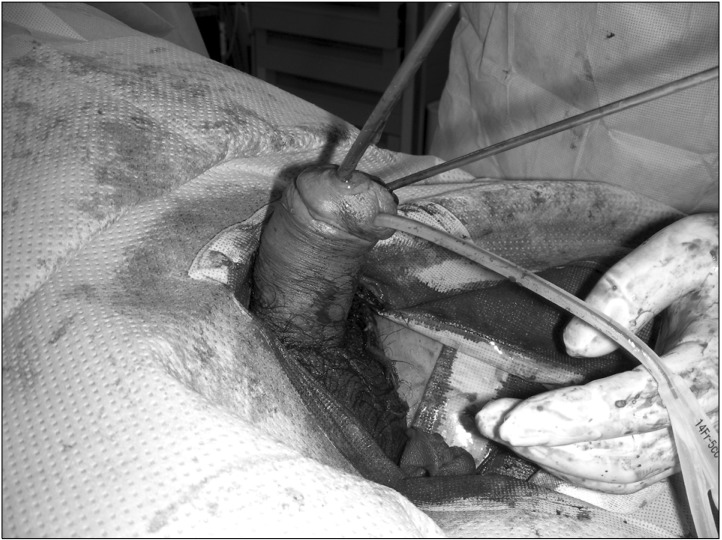Priapism is defined as a full or partial erection that continues more than 4 hours beyond sexual stimulation and orgasm, or that is unrelated to sexual stimulation.1,2
In the treatment guidelines from the American Urological Association in 2003,3 priapism was classified into 3 subtypes: ischemic, non-ischemic, and stuttering. While most cases are idiopathic (50%), hematological diseases, drugs, trauma, and malignant tumors have also been reported to cause priapism. We report a very rare case of stuttering priapism in a patient with neurosyphilis.
CASE REPORT
A 41-year-old male patient with no significant past medical history visited our hospital due to a painful erection that lasted for 6 hours. He had also been seen in the emergency department of another hospital 5 days prior with the same condition. On both occasions, he was treated by aspirating blood from the corpus cavernosum followed by conservative management. The patient was subsequently discharged after detumescence. In our hospital, the patient's vital signs were within normal limits, and physical examination revealed an erection with 90~100% rigidity.
A complete blood count was unremarkable, with a hemoglobin of 17.1 g/dl, red blood cell count of 5,240 k/ul, white blood cell count of 9,900/ul, and platelet count of 246 k/ul. Liver function tests indicated elevated aspartate aminotransferase (82 IU/L), alanine aminotransferase (110 IU/L), and alkaline phosphatase (189 IU/L). Erythrocyte sedimentation rate and C-reactive protein were also increased at 44 mm/h and 24.39 mg/L, respectively. Chemical tests, blood clotting tests, and urinalysis were within normal limits. A corporal blood gas test suggested ischemic priapism, with a pH=6.9, pCO2=146.5 mmHg, and pO2=37 mmHg. Testing for sexually transmitted infections revealed a venereal disease researchlaboratory (VDRL) titer of 1:128, rapid pasma reagin=2.5, and treponema pallidum hemagglutination test titer of 1:2,560 suggesting reactive syphilis. Other tests including Chlamydia and human immunodeficiency virus antibody tests were negative. Color Doppler sonography was not performed due to the irritable state of the patient.
The patient was treated with intramuscular benzathine penicillin G (2,400 kIU) 3 times at intervals of one week. Aspiration of blood from the corpus cavernosum resulted in detumescence, but priapism recurred on 3 occasions over a 4 weeks period. Although intracavernous injection of sympathomimetic drugs was performed, the condition of the patient did not improve. We chose to initiate surgical intervention using a cavernoso-glandular shunt,4 which was performed using a 1 cm incision along the glans (Fig. 1). Post-operatively, complete detumescence was achieved. Since the VDRL titer dropped to 1:64, the titer remained unchanged despite of penicillin treatment. Therefore, we performed a cerebrospinal fluid (CSF) examination to exclude neurosyphilis. On analysis of CSF during hospitalization, the VDRL titer was increased at 1:4. The patient refused further treatment or evaluation and was discharged. The patient died of pancreatic cancer at another hospital several months later.
Go to : 
DISCUSSION
Priapism is a urological emergency that, when not treated properly, may result in fibrosis of the corpus cavernosum and erectile dysfunction. Most cases of priapism are idiopathic. Additionally, erectile agents, antidepressant drugs, trauma, hematologic diseases, hormonal dysregulation, neoplasms, and neurogenic diseases are other potential etiologies of priapism. In neurologic diseases, cerebrovascular accidents, brain tumors, brain or cord injuries, and neurologic infections have been linked to priapism.5 The leading hypothesis for the mechanism is disruption of autonomic nervous system mechanisms that mediate penile vascular muscle tone.6 Priapism caused by nerve infiltration in cases of syphilis, however, has not been reported in the literature.
In the treatment guidelines from the American Urological Association (2003), priapism was divided into subtypes including ischemic, non-ischemic, and stuttering. Stuttering priapism is a variation of ischemic priapism, and is characterized by repetitive, painful, transient episodes, which often require multiple visits to an emergency department.7,8
The cause of stuttering priapism in the Korean population remains unclear. In Western countries, stuttering priapism frequently occurs due to sickle cell disease. The sickled erythrocytes induce venous stasis and congestion, obstructing the penile vessels leading to priapism.9 At present, there is no good medical management approach for the treatment of stuttering priapism, as most therapies fail to prevent the underlying cause, and focus on acute management of priapism.9
In this case, the patient had no significant past medical history, no history of drug use, and no hematological abnormalities. Ischemia was indicated by a cavernosal blood gas study, but the cause of the ischemia was not confirmed. Based on the analysis of serum and cerebrospinal fluid, neurosyphilis was diagnosed and treatment was initiated. Although the erection disappeared following aspiration, additional episodes of priapism recurred over the next 4 weeks. Thus, a cavernoso-glandular shunt was performed. The patient refused further treatment or evaluation, so we could not rule out malignancy as a potential cause of priapism in this patient, as we were unable to perform an autopsy at the time of his death.
We report a case of stuttering priapism in a patient with neurosyphilis that was definitively treated by surgical placement of a cavernoso-glandular shunt. Neurosyphilis was diagnosed on the basis of positive VDRL titers in the serum and cerebrospinal fluid.
Go to : 




 PDF
PDF ePub
ePub Citation
Citation Print
Print



 XML Download
XML Download